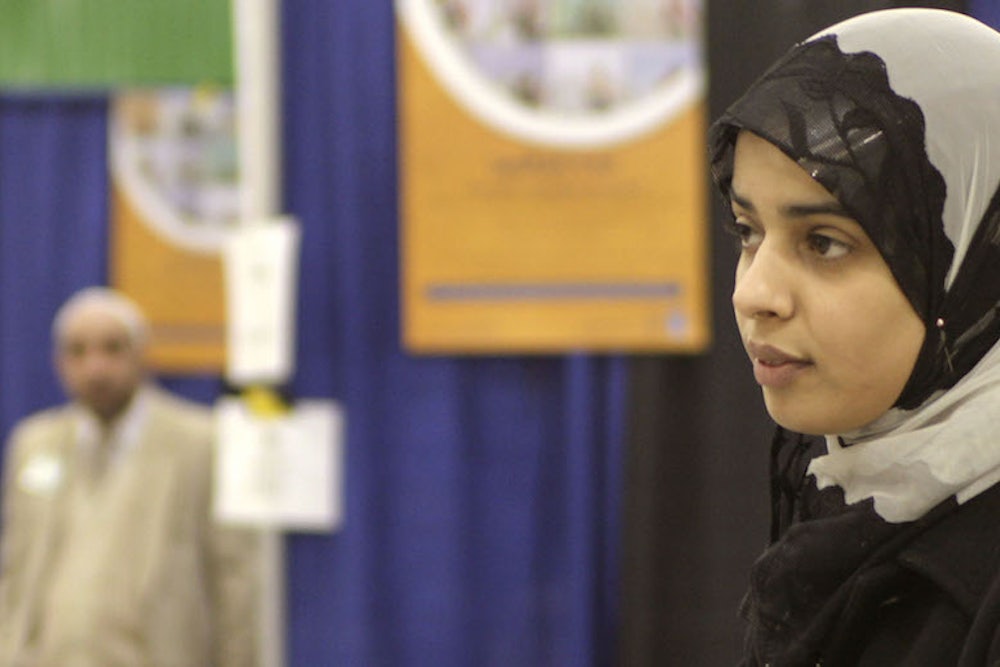In one of the most tasteless scenes in the terrible Sex and the City 2, Carrie and co. finally recognize the humanity of the women of Abu Dhabi when they remove their hijabs and reveal the Western designer outfits they’re wearing underneath. Crass though SATC’s gimmick may be, it’s representative of an attitude that’s widespread in the West: The veil is a symbol of oppression. Most can’t imagine any upsides to wearing one.
New research might make Westerners question that assumption. A study published in the August edition of the British Journal of Psychology suggests that the hijab actually offers some protection against the body dissatisfaction that plagues many Western women. A team of psychologists, led by Malaysian-born British psychologist Viren Swami at the UK’s University of Westminster, interviewed 587 Muslim women in London, 369 of whom regularly wore some sort of hijab. Their ages ranged from 18 to 70; the mean age was 27. The majority—about 79 percent—were unmarried, and they represented several ethnic groups—Bengali, Pakistani, Indian, and Arab. More than three-quarters held an undergraduate degree.
Swami and his team gave the women several tests to measure their attitudes toward their bodies—and the women who wore Western dress scored higher on every scale of body dissatisfaction. When subjects were asked to look at several sketches of women’s bodies and pick the one they would most like to have, the choices of the women who wore the hijab more closely resembled the bodies they actually possessed. On a measure of “drive for thinness”—determined by answers to questions about preoccupation with body weight, fear of becoming fat, and excessive concern with dieting—women who didn’t wear the hijab scored, on average, 3.58 out of 6 points, compared to 2.87 for women who cover up. Women who wore Western dress also registered a higher degree of “social physique anxiety,” or concern with how others perceived their physical appearance: 3.26, versus 2.92, on the 6-point scale.
Women in Western dress were also more likely to deem various forms of media an “important source of information about being attractive.” And they scored higher on a measure of the degree to which they accepted as normal unrealistic ideals of beauty (3.09 versus 2.43). Women in hijabs also spent less time engaging in “appearance-management behaviors,” and ranked their own appearance as less important than did women who wore Western clothes.
The researchers concluded that it wasn’t just the womens' faith that was making them less susceptible to idealized depictions of beauty. “It might thus be concluded that use of the hijab offers Muslim women a small protective effect in terms of their body image … the use of the hijab may act as a buffer against negative body image,” write the authors. The veil, in other words, might be oppressive—but so are unrealistic beauty standards.
Of course, all this evokes a sense of a conservative argument for the hijab: "The hijab is not a proscription or a burden—just look at the benefits!" I asked Swami if he had any discomfort with this impression, and he told me, "We’re not making a judgment” one way or the other. “We’re certainly not saying that everyone should be wearing a hijab.”
And there might be any number of other reasons for the disparity in self-image between the cohort of women who wear the hijab and those who don't. Perhaps cultural factors related, but not directly derived from the prevalence of the hijab, affect how women talk about their bodies. In societies where the hijab is more prevalent, many choices are foreclosed to women, and that may affect how they conceive of and talk about their bodies.
Other bodily pressures may actually manifest more strongly in women who wear the hijab. Because their figures are less visible, they may feel more pressure relating to their faces. Per capita rates of nose jobs in Iran are seven times what they are in the U.S.; the country has even been called the “nose job capital of the world.” The cosmetics industry is booming in the Arab world.
Though they may confer some collateral benefits on wearers, hijabs can’t exactly be promoted as a solution for body anxieties.
